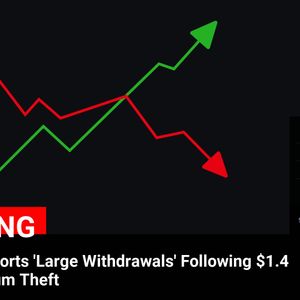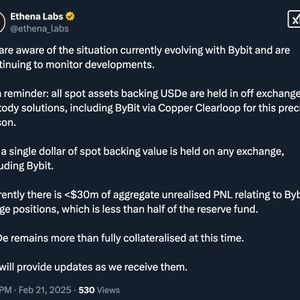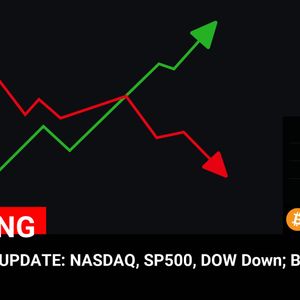Cryptocurrency investors often keep a close watch on traditional financial markets for cues about global economic trends and currency movements. Recent developments in the UK, specifically concerning UK Inflation and the Pound Sterling , are creating ripples that are worth noting. The Pound Sterling has shown vulnerability after the latest inflation data from the UK painted a hotter-than-expected picture. But is this a cause for alarm, or just a temporary bump in the road? Let’s dive into the details. Why is the Pound Sterling Under Pressure? The Pound Sterling is experiencing headwinds primarily due to a recent UK inflation report that exceeded forecasts. Here’s a breakdown of what happened: Headline CPI Soars: The Consumer Price Index (CPI) for January revealed a 3% increase year-over-year, surpassing both the anticipated 2.8% and the previous month’s 2.5%. Core Inflation Stays Strong: Core CPI, excluding volatile items, rose by 3.7%, matching expectations but still higher than the previous 3.2%. Services Sector Inflation Accelerates: A key area of concern for the Bank of England (BoE), services sector inflation jumped to 5% from 4.4% in December. This unexpected surge in UK Inflation has led to market jitters and a subsequent weakening of the Pound Sterling against major currencies. Bank of England’s Stance: Temporary Inflation Spike? Despite the concerning inflation figures, the Bank of England (BoE) maintains a relatively dovish stance. Governor Andrew Bailey has indicated that the central bank believes this uptick in UK Inflation is likely to be temporary. Here’s what we know about the BoE’s perspective: Short-Term Energy Price Impact: The BoE attributes the current inflationary pressure to rising energy prices, expecting this to be a short-lived effect. “Gradual Disinflation” Expected: Bailey reassured markets that the BoE still anticipates a “gradual disinflation” process to bring inflation back to their 2% target. Economic Sluggishness as Counterforce: The BoE also believes that the “sluggish state” of the UK economy will naturally act as a dampener on inflation. This confidence from the Bank of England is crucial as it shapes market expectations regarding future monetary policy and the trajectory of Interest Rates . Market Movers: GBP Performance and Global Factors Let’s examine how the Pound Sterling is performing against other major currencies and the broader market context: British Pound (GBP) Price Today: Currency Heatmap The table below provides a snapshot of the Pound Sterling’s percentage change against major currencies today. It reveals where the GBP is showing strength and weakness. USD EUR GBP JPY CAD AUD NZD CHF USD 0.25% 0.14% -0.20% 0.11% -0.02% -0.26% 0.07% EUR -0.25% -0.10% -0.44% -0.13% -0.27% -0.50% -0.18% GBP -0.14% 0.10% -0.34% -0.03% -0.17% -0.40% -0.08% JPY 0.20% 0.44% 0.34% 0.30% 0.17% -0.08% 0.25% CAD -0.11% 0.13% 0.03% -0.30% -0.13% -0.38% -0.05% AUD 0.02% 0.27% 0.17% -0.17% 0.13% -0.23% 0.09% NZD 0.26% 0.50% 0.40% 0.08% 0.38% 0.23% 0.32% CHF -0.07% 0.18% 0.08% -0.25% 0.05% -0.09% -0.32% The heat map illustrates percentage changes of major currencies against each other. Base currency from the left column, quote currency from the top. For example, GBP/USD change is found at the intersection of British Pound (left) and US Dollar (top). GBP/USD Pair Under Pressure The GBP/USD pair is currently trading near 1.2580, reflecting the Pound Sterling’s weakness against a strengthening US Dollar. Several factors are contributing to this: Dollar Strength: The US Dollar Index (DXY) is climbing, fueled by anticipation for the Federal Open Market Committee (FOMC) minutes. FOMC Minutes in Focus: Investors are keenly awaiting the FOMC minutes to glean insights into the Federal Reserve’s (Fed) future Interest Rates policy. Trump’s Tariff Threats: Renewed threats of tariffs by former US President Trump are adding to global economic uncertainty and bolstering the safe-haven appeal of the US Dollar. These global dynamics are further influencing the trajectory of the Pound Sterling . Technical Outlook for GBP/USD From a technical analysis perspective, the GBP/USD pair is facing resistance around the 1.2620 level, which coincides with the 38.2% Fibonacci retracement and the 100-day Exponential Moving Average (EMA). Key technical points to watch include: Resistance at 1.2620: Breaking above this level is crucial for any potential bullish reversal. RSI Struggle: The 14-day Relative Strength Index (RSI) is struggling to maintain momentum above 60.00, indicating waning bullish pressure. Support at 1.2250: The February 3 low of 1.2250 serves as a significant support level if the downside pressure intensifies. Resistance at 1.2767: On the upside, the 50% Fibonacci retracement at 1.2767 is a key resistance target. Traders are closely monitoring these technical levels to gauge the next move for the GBP/USD pair. Understanding the UK Consumer Price Index (CPI) The Consumer Price Index (CPI) is a critical economic indicator for the UK. Here’s why it matters: Inflation Gauge: CPI measures the rate at which prices of goods and services consumed by households change. BoE’s Target: The Bank of England uses CPI as the primary measure to monitor and manage inflation, aiming to keep it around 2%. Monetary Policy Impact: Higher UK Inflation readings can prompt the BoE to consider raising Interest Rates or reducing bond-buying, tightening monetary policy to control price increases. GBP Sensitivity: Generally, a higher-than-expected CPI reading is considered bullish for the Pound Sterling , while a lower reading is bearish. However, in the current context, the BoE’s dovish stance is tempering the typical bullish reaction. The CPI data release is a key event on the economic calendar, influencing market sentiment and currency valuations. Conclusion: Navigating the Pound Sterling’s Path The Pound Sterling is currently navigating a complex landscape. While UK Inflation has surprised to the upside, the Bank of England remains confident that this surge is temporary. However, market participants are closely watching incoming economic data, especially Retail Sales and PMI figures, to get a clearer picture of the UK’s economic health. The interplay between domestic inflation, Bank of England policy, and global factors like US Dollar strength and trade tensions will continue to shape the Pound Sterling’s trajectory in the near term. For cryptocurrency traders, understanding these macroeconomic currents is essential, as currency fluctuations can impact broader market sentiment and risk appetite. To learn more about the latest Forex market trends, explore our article on key developments shaping US Dollar and interest rates liquidity.



















